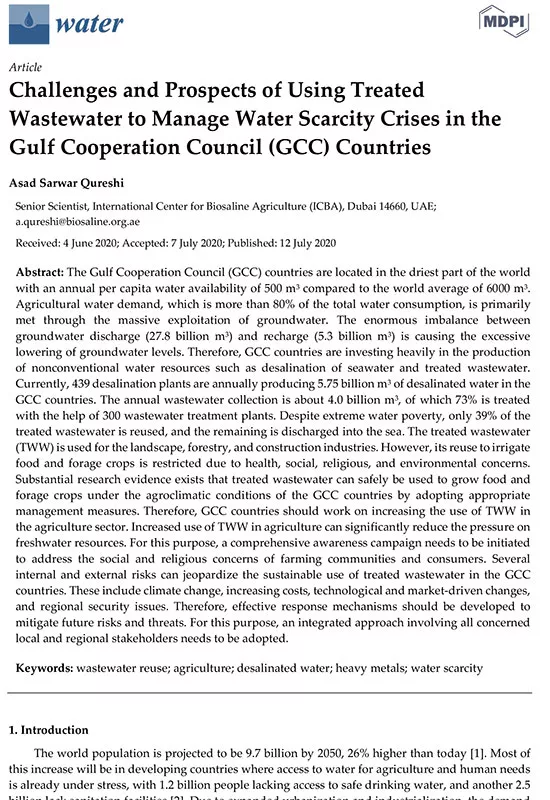Challenges and Prospects of Using Treated Wastewater to Manage Water Scarcity Crises in the Gulf Cooperation Council (GCC) Countries
The Gulf Cooperation Council (GCC) countries are located in the driest part of the world with an annual per capita water availability of 500 m3 compared to the world average of 6000 m3. Agricultural water demand, which is more than 80% of the total water consumption, is primarily met through the massive exploitation of groundwater. The enormous imbalance between groundwater discharge (27.8 billion m3) and recharge (5.3 billion m3) is causing the excessive lowering of groundwater levels. Therefore, GCC countries are investing heavily in the production of nonconventional water resources such as desalination of seawater and treated wastewater. Currently, 439 desalination plants are annually producing 5.75 billion m3 of desalinated water in the GCC countries. The annual wastewater collection is about 4.0 billion m3, of which 73% is treated with the help of 300 wastewater treatment plants. Despite extreme water poverty, only 39% of the treated wastewater is reused, and the remaining is discharged into the sea. The treated wastewater (TWW) is used for the landscape, forestry, and construction industries. However, its reuse to irrigate food and forage crops is restricted due to health, social, religious, and environmental concerns. Substantial research evidence exists that treated wastewater can safely be used to grow food and forage crops under the agroclimatic conditions of the GCC countries by adopting appropriate management measures. Therefore, GCC countries should work on increasing the use of TWW in the agriculture sector. Increased use of TWW in agriculture can significantly reduce the pressure on freshwater resources. For this purpose, a comprehensive awareness campaign needs to be initiated to address the social and religious concerns of farming communities and consumers. Several internal and external risks can jeopardize the sustainable use of treated wastewater in the GCC countries. These include climate change, increasing costs, technological and market-driven changes, and regional security issues. Therefore, effective response mechanisms should be developed to mitigate future risks and threats. For this purpose, an integrated approach involving all concerned local and regional stakeholders needs to be adopted.
Year
2020
Publication Source
Water
Publication type
Article
Volume/Chapter/Issue
12











